Marulanda J.M. (ed.) Electronic Properties of Carbon Nanotubes
Подождите немного. Документ загружается.


Low-Energy Irradiation Damage in Single-Wall Carbon Nanotubes
335
Fig. 5. (a) G and D band spectra of pristine and electron-irradiated SWCNTs, showing the
acceleration voltage dependence of electron irradiation damage. The irradiation dose was
2.7×10
18
cm
-2
. (b) RBM spectra of pristine SWCNTs (black lines) and SWCNTs illuminated
by 6-10 eV photons (red). Because the spectra were originally slightly sample-dependent,
spectra before and after the irradiation are shown for each photon energy. (c) G/D area ratio
of pristine SWCNTs and SWCNTs irradiated at various photon energies. In (b) and (c), the
photon dose was 5×10
17
cm
-2
except for
*
2 and
*
3 in (c). The excitation wavelength was 785
nm.
*
1) higher order light cut by a pyrex window.
*
2) very intense unmonochromatized light
through a pyrex window (h3.5 eV).
*
3) The photon dose was 2.5×10
17
cm
-2
.
smaller energy. A high-energy electron or photon easily penetrates a SWCNT without any
electric excitation. An exception is when the photon energy is tuned to near the C 1s
absorption edge, for which severer damage was observed than at the energy below the
absorption threshold. However, the resonance effect does not seem to be very prominent, as
will be shown in Fig. 11(b).
The existence of the threshold energy is also expected for the low-energy irradiation
damage. As seen in the RBM spectra shown in Fig. 5(b), distinct spectral intensity decreases
are observed at 6 eV or larger for semiconducting SWCNTs with diameters of about 1.2-1.0
nm at 200-240 cm
-1
(Suzuki & Kobayashi, 2008). Decreases in the G/D ratio are also clearly
Intensity (arb.units)
170016001500140013001200
Raman Shift (cm
-1
)
unirradiated
25 kV
5 kV
1 kV
G
D
(a)
Intensity (arb. units)
300250200150100
Raman shift (cm
-1
)
6 eV
7 eV
8 eV
9 eV
10 eV
(b)
*1 *2
*3
G/D ratio
12
10
8
6
4
2
0
G/D area ratio
1816141210864
Photon enegy (eV)
pristine
irradiated
*1 *2
*3
G/D ratio
12
10
8
6
4
2
0
G/D area ratio
1816141210864
Photon enegy (eV)
pristine
irradiated
(c)
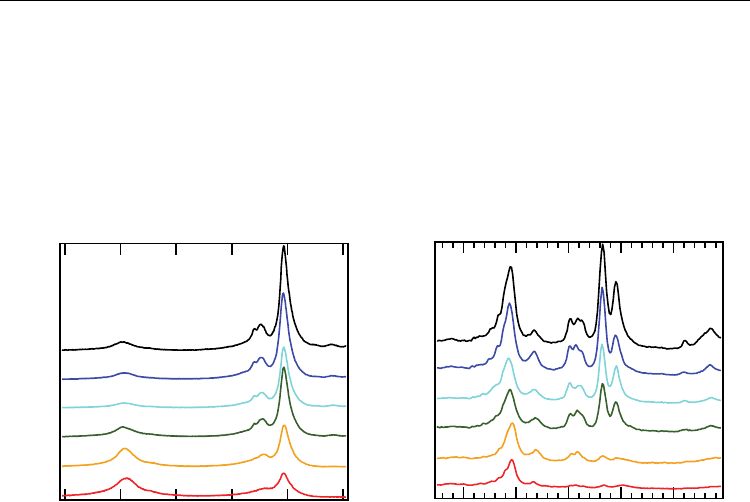
Electronic Properties of Carbon Nanotubes
336
observed at 6 eV or higher, as shown in Fig. 5(c). Notably, the damage in metallic SWCNTs
with diameters of 1.6 nm at 140-160 cm
-1
is not clear up to 8 eV. This is because of the
diameter dependence of low-energy irradiation damage, as discussed in sec. 4.3. In electron
(hole) tunneling injection studies using a scanning tunneling microscope (STM), slightly
lower threshold energy of 4 eV has been observed (Yamada et a., 2009). The reason for the
discrepancy may be that the threshold energy depends on the diameter, chirality, or detailed
defect structures. Anyway the threshold energy of the low-energy irradiation damage seems
to be several electron volts.
Fig. 6. (a) G and D band, and (b) RBM spectra of unirradiated, photon-irradiated, and
annealed SWCNTs. The SWCNTs were irradiated by unmonochromatized synchrotron
radiation light (h1 keV) up to a dose of 8×10
20
cm
-2
. The excitation wavelength for the
Raman measurements was 633 nm.
4.2 Reversible damage and recovery
Probably the most important characteristic of the low-energy irradiation damage is the
reversibility of the damage and recovery. Figure 6 shows Raman spectra of SWCNTs before
and after VUV light irradiation and of SWCNTs annealed at 300, 600, 800, 900 C. The
irradiation caused severe damage and drastically decreased the G/D ratio and the RBM
intensities. All the RBM peaks above 200 cm
-1
corresponding to a diameter less than 1.2 nm
almost completely disappeared. However, the annealing at 300, 600, and 800 C gradually
recovered the spectra, and at 900 C, all the peaks including the once disappeared peaks are
almost fully recovered. I would like to point out once again that the spectra were not
normalized at all. Thus, the results reveal that not only the spectral shape but also the
spectral intensity itself is almost fully recovers by annealing.
The reversible damage and recovery is also observed in the electric properties. As
mentioned in sec. 3.3, the low-energy irradiation damage almost extinguishes the electric
conductivity. However, the extinguished conductivity is also fully recoverd by annealing, as
shown in Fig. 7(a). An originally metallic SWCNT device was intensively irradiated in a
SEM using the line scan mode. The irradiation extinguished the conductivity and made the
SWCNT almost insulating. However, the conductivity was fully recovered by annealing in a
Intensity (arb. units)
170016001500140013001200
Raman shift (cm
-1
)
(a)
unirradiated
900 °C
800 °C
600 °C
300 °C
irradiated
Intensity (arb. units)
350300250200150
Raman shift (cm
-1
)
unirradiated
900 °C
800 °C
600 °C
300 °C
irradiated
(b)
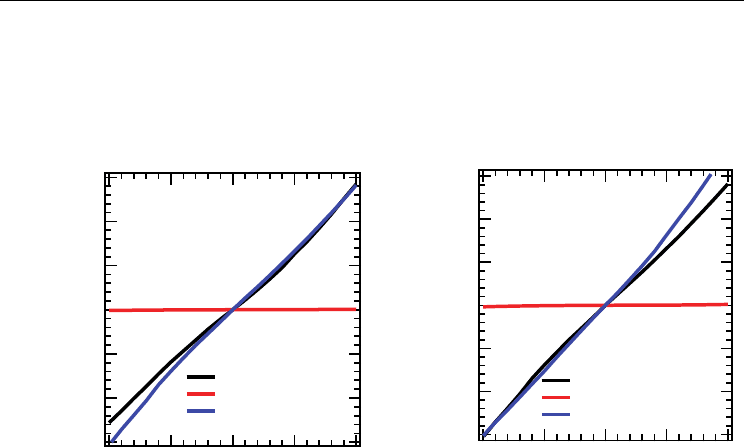
Low-Energy Irradiation Damage in Single-Wall Carbon Nanotubes
337
vacuum at 300 C. Moreover, the reversibility can be observed repeatedly, as shown in Fig.
7(b). The complete reversibility of the electric properties has also been observed by another
group, although they attribute the conductivity decrease and recovery to substrate charging
and its release (Marquardt et al., 2008. and Vijayaraghavan et al., 2010). I will discuss this
issue later in sec. 7.4.
Fig. 7. (a) Electric properties of a SWCNT device before and after the first electron
irradiation and after annealing. The SWCNT was intensively irradiated by electrons of 20
keV up to a dose of 1×10
20
cm
-2
. Then, the irradiated device was annealed at 300 C in Ar
atmosphere for 30 min. (b) The electric properties of the same SWCNT device before and
after the second irradiation and after the second annealing. The SWCNT was intensively
irradiated again by 20-keV electrons up to a dose of 1.7×10
20
cm
-2
. After the irradiation, the
SWCNT was annealed at 300 C for 30 min and fully recovered again.
The reversibility of the damage and recovery indicates that the damage is not accompanied
by a reduction of carbon atoms and that the number of carbon atoms is preserved. Recently,
Mera et al. directly measured ion desorption from SWCNTs under soft X-ray illumination
(Mera et al, 2010). They also excluded emission of carbon atoms from the SWCNTs.
4.3 Diameter dependence
Another important characteristic of the low-energy irradiation damage is that strong
diameter dependence is observed when the irradiation is done at room temperature or
above (Suzuki and Kobayashi, 2006). For example, in the RBM and PL spectra shown in
Figs. 1, 2, 5, and 6, we can clearly see the diameter dependence of the damage; that is,
thinner SWCNTs are more severely damaged. Especially, in Fig. 1(c), we can see a large
difference in the extent of the damage due to very small diameter difference. The SWNTs
observed at about 1151 and 1172 nm can be assigned to (12,1) and (11,3) tubes having
diameters of 0.995 and 1.014 nm, respectively. These two peaks were considerably
weakened by the photon irradiation at 250 C. On the other hand, the occurrence of the
damage was not obvious for thicker SWNTs after the same irradiation dose at 250 C. The
peaks at 1224 nm is assigned to (10,5) tubes having a diameter of 1.050 nm. The diameter
-3x10
-6
-2
-1
0
1
2
3
Current (A)
-1.0 -0.5 0.0 0.5 1.0
Voltage (V)
before 2nd irradiation
after 2nd irradiation
after 2nd annealing
(b)
-3x10
-6
-2
-1
0
1
2
3
Current (A)
-1.0 -0.5 0.0 0.5 1.0
Voltage (V)
before irradiation
after irradiation
after annealing
(a)
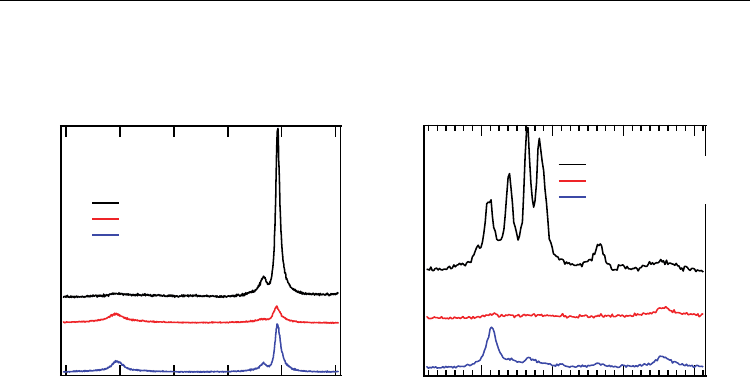
Electronic Properties of Carbon Nanotubes
338
difference between the considerably damaged (11,3) and hardly damaged (10,5) tubes is
only 0.037 nm. It is very interesting that such a small diameter difference results in the
distinctly different sensitivity to the irradiation.
Fig. 8. (a) G and D band and (b) RBM spectra of pristine, irradiated, and partially recovered
SWCNTs. The SWCNTs were irradiated by 1-keV electrons up to a dose of 8×10
17
cm
-2
.
Then, the damaged SWCNTs were partially recovered by annealing at 400 C in Ar
atmosphere for 30 min. The excitation wavelength was 785 nm. In (b), the hump at 300 cm
-1
is from the Si substrate.
The diameter dependence is observed in the recovery process, as shown in Fig. 8. The
electron irradiation largely decreased the G/D ratio (a) and once almost completely
extinguished all of the RBM peaks (b). The sample was partially recovered by annealing at
400 C. Then, only the peak at about 205 cm
-1
, corresponding to the thickest SWNTs among
the initially observed ones, significantly recovered.
The diameter dependence of damage is more or less also observed in knock-on damage
(Krasheninnikov & Nordlund, 2010) and damage by radicals (Yang et al., 2006, Zhang et al.,
2006b). However, the diameter dependence of low-energy irradiation damage is more
prominent, as mentioned above. The damage caused by knock-on collision and radicals also
occurs in thick MWCNTs and graphite, but the low-energy irradiation damage has not. Also
noteworthy is that the diameter dependence is not prominent when SWCNTs are irradiated
at low temperature, as shown in the next section.
4.4 Temperature dependence of the damage
Severer damage is observed at lower temperatures (Suzuki & Kobayashi, 2007a). As shown
in Fig. 1, the irradiation at 250 C results in much less damage than at 22 C. The
temperature dependence is seen at lower temperatures, and less damage is observed at -27
C than at -267 C (6 K), as shown in Fig. 9. These results suggest that low-energy
irradiation-induced defects can be healed even at -27 C. In fact, the electric conductivity of
irradiated SWCNTs gradually recovers at room temperature, as shown in Fig. 10 (Suzuki &
Kobayashi, 2007). The temperature dependence of the damage is completely opposite to that
observed in gas phase reactions (An et al., 2002, Zhang et al., 2006a).
Intensity (arb. units)
170016001500140013001200
Raman shift (cm
-1
)
(a)
unirradiated
irradiated
partially recovered
Intensity (arb. units)
320280240200
Raman shift (cm
-1
)
unirradiated
irradiated
partially recovered
(b)
Si
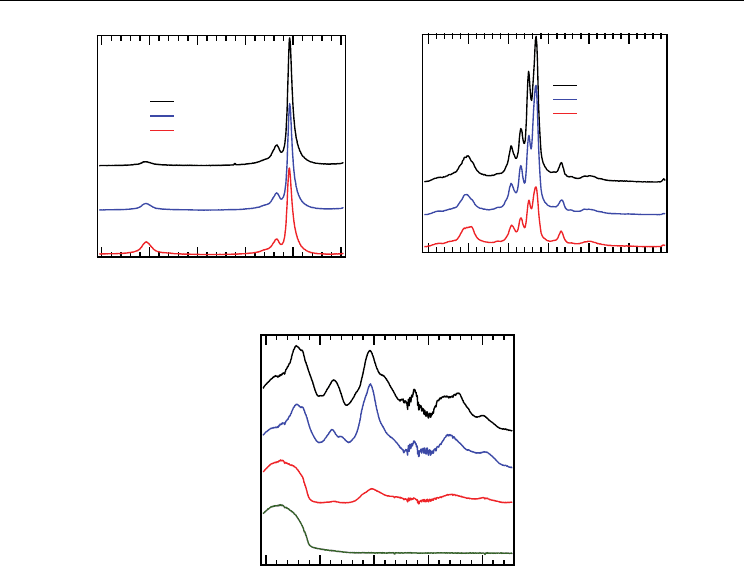
Low-Energy Irradiation Damage in Single-Wall Carbon Nanotubes
339
Fig. 9. (a) G and D band, (b) RBM, and (c) PL spectra of pristine SWCNTs and of SWCNTs
irradiated at -27, and -267 C. The SWCNTs were irradiated by 40-eV photons up to a dose
of 7.2×10
17
cm
-2
. The excitation wavelength was 785 nm. In (b), the hump at 300 cm
-1
is
from the Si substrate.
Fig. 9(b) also shows that the diameter dependence of the damage is less prominent at -27 C,
meaning that the recovery of all the observed SWCNTs is almost completely forbidden at
this temperature, regardless of the diameter. In other words, the less damage in a thicker
SWCNT observed at room temperature and above is a consequence of the fact that a defect
created in the thicker SWCNT can be more quickly healed by the thermal energy at the
irradiation temperature. The diameter dependence can mainly be ascribed to the diameter
dependence of the defect healing rather than to that of defect creation.
4.5 Activation energy of defect healing
The recovery of the damage at room temperature or below suggests that the activation
energy of the defect healing is quite small. We have proposed a simple method for
determining the activation energy of defect healing in SWCNTs (Suzuki et al., 2010). For
example, recovery curves of the G/D ratio can be used for the analysis. In Fig. 11(a), we
show Raman spectra of SWCNTs before and after irradiation and after 2, 14, and 64 min
annealing at 240 C. The annealing gradually recovered the irradiated SWCNTs. From these
Intensity (arb. units)
170016001500140013001200
Raman shift (cm
-1
)
unirradiated
-27 °C
-267 °C
(a)
Intensity (arb. units)
350300250200150100
Raman shift (cm
-1
)
unirradiated
-27 °C
-267 °C
(b)
Intensity (arb. units)
15001400130012001100
Wavelength (nm)
unirradiated
-27 °C
-267 °C
substrate
(c)
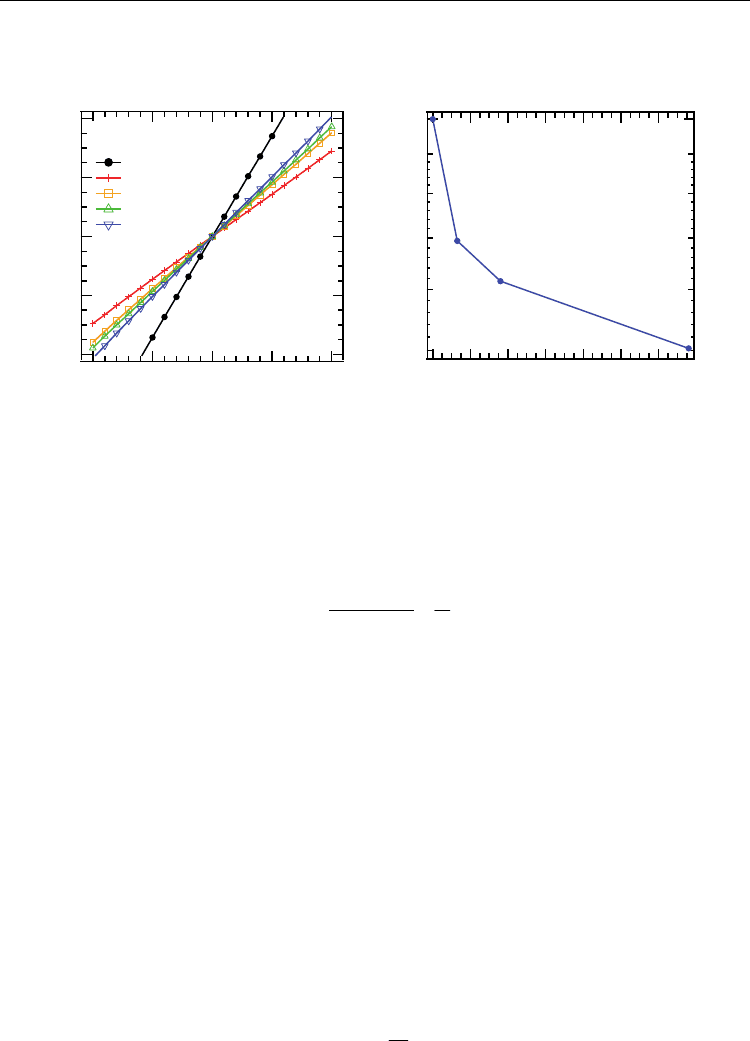
Electronic Properties of Carbon Nanotubes
340
measurements, we obtained recovery curves of the G/D ratio at several temperatures, as
shown in Fig. 11(b). The reason for the relatively small values of the G/D ratio is that we
adopted the area ratio rather than the peak height ratio, in order to decrease static errors.
Fig. 10. (a) Current-voltage characteristics of a SWCNT device before and just after electron
irradiation and 13, 36, 136 min after the irradiation. The electron energy and irradiation dose
were 20 keV and 1.8×10
15
cm
-2
,respectively. (b) Time evolution of the irradiation-induced
resistance (R) at 22 C. The initial value of the irradiation-induced resistance (Ro) was 19.8
kΩ.
The activation energy E
a
of defect healing is given by
1
11
2
12
ln
a
kt
E
t
TT
(1)
where t
1
and t
2
are annealing times during which the G/D ratio R increases from R
1
to R
2
.
Here, it is sufficient that the G/D ratio is just a monotonic function of the defect density (We
do not have to assume a specific relation between the G/D ratio and defect density, such as
that the G/D ratio is inversely proportional to the defect density). The activation energy
seems to depend on the extent of the damage. In the region of 2.8R3.0 (heavily damaged),
we obtained an activation energy value of 1.4 0.2 eV, as shown in Fig. 11(c), from the
recovery curves at 140 and 120 C and eq. (1), whereas at 6R6.5 (lightly damaged), a
smaller value of 0.7 0.2 eV was obtained. I would like to mention that these values may be
affected by gas absorption at defect sites, because the SWCNTs were once exposed to air
after the irradiation. Anyway, the values are small enough for the defects to be healed at
moderate temperatures.
Interestingly, although a partial recovery of low-energy irradiation damage at room
temperature is easily observed in the electric properties (Fig. 10), it has not been observed in
Raman spectra. Once we obtain the activation energy value, we can estimate the recovery
curve at a given temperature T
3
. Using the recovery curve R
1
(R
2
) at T
1
(T
2
), the recovery
curve at T
3
is given by
11
3 3 1,2 3 1,2 3
exp .
a
E
Rt R t T T
k
(2)
-4
-2
0
2
4
Current (A)
-0.10 -0.05 0.00 0.05 0.10
Voltage (V)
pristine
irradiated
13 min
36 min
136 min
(a)
5
6
7
8
9
1
R/Ro
120100806040200
Time (min)
(b)
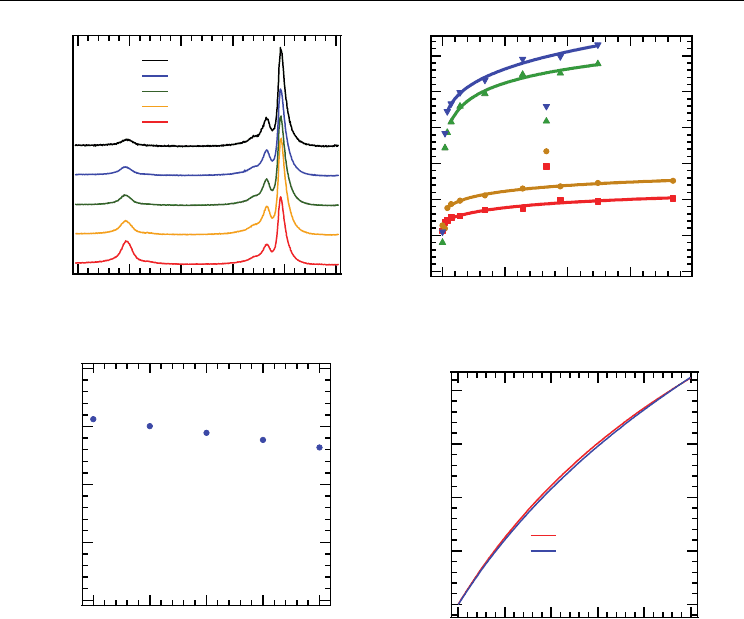
Low-Energy Irradiation Damage in Single-Wall Carbon Nanotubes
341
Fig. 11. (a) Raman spectra of SWCNTs before and after electron irradiation and after
annealing at 240 C. The electron energy and dose were 20 keV, and 8×10
16
cm
-2
,
respectively. The excitation wavelength was 785 nm. (b) Recovery curves of the G/D area
ratio otbained at several annealing temperatures. (c) Activation energy of the defect healing
obtained from the recovery curves at 140 and 120 C. (d) Simulated recovery curves of the
G/D ratio at room temperature (20 C) obtained from the recovery curves at 120 and 140 C
in (b), respectively.
Fig. 11(d) shows the recovery curves at 20 C simulated from the experimental recovery
curves at 140 and 120 C and eq. (2). The two independently obtained curves are almost
consistent. Note that the unit of the horizontal axes is “year”. Recovery of the G/D ratio
from 2.8 to 3.0 at 20 C would take about 230 years. Similarly, the recovery from 6.0 to 6.5 at
20 C was estimated to take about 7 years (Suzuki et al., 2010). Thus, the recovery would be
much too slow to observe at room temperature in usual experiments. The very long
recovery time at room temperature is a consequence of the relatively slow recovery at
elevated temperatures in Raman spectra. On the other hand, the recovery of the electric
properties is much more rapid. Annealing at 300 C for 30 min often results in recovery of
conductivity of several orders of magnitude, as already shown in Fig. 7.
2.0
1.5
1.0
0.5
0.0
Activation energy (eV)
3.002.952.902.852.80
G/D area ratio
(c)
3.00
2.95
2.90
2.85
2.80
G/D area ratio
250200150100500
Time (year)
from 120 °C curve
from 140 °C curve
(d)
7
6
5
4
3
2
1
G/D area ratio
150100500
Annealing time (min)
240 °C
220 °C
140 °C
120 °C
(b)
Intensity (arb. units)
170016001500140013001200
Raman shift (cm
-1
)
pristine
64 min
14 min
2 min
irradiated
(a)
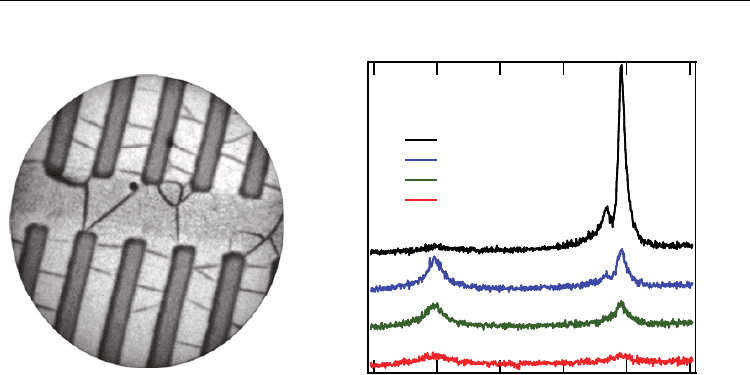
Electronic Properties of Carbon Nanotubes
342
Fig. 12. (a) LEEM image of suspended SWNTs on a patterned Si substrate. (b) G and D band
Raman spectra of unirradiated and soft X-ray-illuminated (280. 0 and 285.5 eV) SWCNTs
and electron-irradiated (20 eV) SWCNTs. The excitation wavelength was 785 nm. The soft
X-ray illumination was done at BL-27SU at SPring-8, Hyogo, Japan. The electron irradiation
was a consequence of LEEM observation. The soft X-ray and electron irradiations were done
after thorough degassing.
Though we evaluate the activation energy from the G/D ratio here, any other quantity that
is a monotonic function of the defect density can basically be used for the analyses. This
method can also be used to analyze other kinds of defects and desorption barriers of
chemisorbed atoms or molecules on SWCNTs.
4.6 Occurrence of the damage in an ultra-high vacuum
As I mentioned in sec. 2, the low-energy irradiation damage is caused by the irradiation
itself. We found that the damage does not depend on the remnant gas pressure at 10
-4
Pa or
below (Suzuki et al., 2008). The low-energy irradiation damage has been observed in a
surface-science-grade ultra-high vacuum (UHV) of 1×10
-8
Pa by VUV light illumination
(Suzuki & Kobayashi, 2006a. Suzuki & Kobayashi, 2007a, Mera et al., 2009. Mera et al.,
2010.), electron beam irradiation (Arima et al., 2009.), and electron (hole) injection from a
STM tip (Berthe et al., 2007. Yamada et al., 2009). The damage occurs as ever when SWCNTs
are thoroughly degassed in a UHV before irradiation. Other examples of occurrence of the
damages in UHV surface analysis systems are shown in Fig. 12(b). The SWCNTs were
irradiated by electrons during LEEM observation [Fig. 12(a)] or by soft X-rays at a
photoemission spectroscopy beamline attached to a synchrotron radiation ring. The damage
to SWCNTs is especially severe in LEEM observation using very low-energy electrons of
several tens electron volts, due to the energy dependence of the damage (sec. 4.1). In an
UHV, no irradiation-induced change is observed even in high-energy-resolution
(a)(a)
Intensity (arb. units)
170016001500140013001200
Raman shift (cm
-1
)
unirradiated
280.0 eV
285.5 eV
LEEM
(b)
Intensity (arb. units)
170016001500140013001200
Raman shift (cm
-1
)
unirradiated
280.0 eV
285.5 eV
LEEM
(b)

Low-Energy Irradiation Damage in Single-Wall Carbon Nanotubes
343
photoemission spectroscopy (Suzuki et al., 2004a), indicating that chemical reactions with
gas molecules are negligible. Nevertheless, very severe damage is observed in Raman
spectra.
4.7 Structure dependence
A low-energy electron and photon can easily dissociate a small molecule (for example,
photodissociation). On the other hand, such low-energy irradiation damage (or structural
change) is not commonly observed inside the bulk of a metal or semiconductor. Actually,
it has not been reported for graphite. Very interestingly, even among CNTs, the damage
has been reported for SWCNTs but not for MWCNTs. An electron irradiation experiment
in an SEM has shown that the irradiation causes no reduction of the conductivity of
MWCNTs with a diameter of 10 nm (Bachtold et al., 1998. Hobara et al., 2004). The
irradiation conditions used in those studies (4 Ccm
-2
of 20-keV and 20 Ccm
-2
of 10-keV
electrons) roughly correspond to 10 to 1000 fold of a value that can cause a SWCNT
conductivity decrease of a few orders of magnitude (Suzuki, 2011). Thus, the damage seems
to be specific to SWCNTs or thin CNTs with a diameter of 1 nm. Even among SWCNTs,
the extent of the damage strongly depends on the diameter: Thinner SWCNTs are more
severely damaged, as discussed in section 4.3.
The diameter dependence of the damage may explain the occurrence of the damage in
SWCNTs and its absence in MWCNTs and graphite. Considering that the damage strongly
depends on the diameter among SWCNTs, it would be possible that a MWCNT of 10-nm
diameter is no longer damaged by low-energy irradiation at room temperature. If the
occurrence and the absence of the damage originate in the diameter difference, we can
expect that strain in the sidewall plays an essential role in the defect formation or its
stabilization. Alternatively, it is interesting to view the occurrence and absence of the
damage in terms of dimensionality. Graphite, in which the damage does not occur, is a
three-dimensional material, and a SWCNT, in which the damage occurs, is a one-
dimensional material. Notably, it has been well established that structural changes occur in
zero-dimensional fullerenes by photon and electron irradiation (Zhao et al., 1994. Onoe et
al., 2003). This is generally described as “polymerization” instead of damage, because the
irradiation causes chemical bonds to form between neighboring fullerenes. The structural
change can be reversibly restored by annealing, exactly like the low-energy irradiation
damage of a SWCNT. The electronic states, which spread in the whole crystal in a bulk
material, should be localized in low-dimensional materials or nanomaterials, and the
degrees of freedom of atomic movement should become larger. Thus, in low-dimensional
materials or nanomaterials, local structural change would easily occur with low-energy
irradiation and the defect structure would be stabilized (See also sec. 6).
In terms of the relation between the damage and structure, it is very interesting to explore
whether the damage occurs in graphene, which is a two-dimensional material and can be
considered to be a SWCNT of infinite diameter. Zhou et al. reported that soft x-ray
illumination damages graphene, on the basis of their C 1s x-ray absorption and Raman
spectroscopy results (Zhou et al., 2009). Very interestingly, the illumination effects increased
with a decreasing number of layers of exfoliated graphene and were negligible even for
monolayer epitaxial graphene on SiC, which has a relatively strong interaction with the
substrate. These results suggest that low dimensionality is strongly related to the low-
energy irradiation damage.
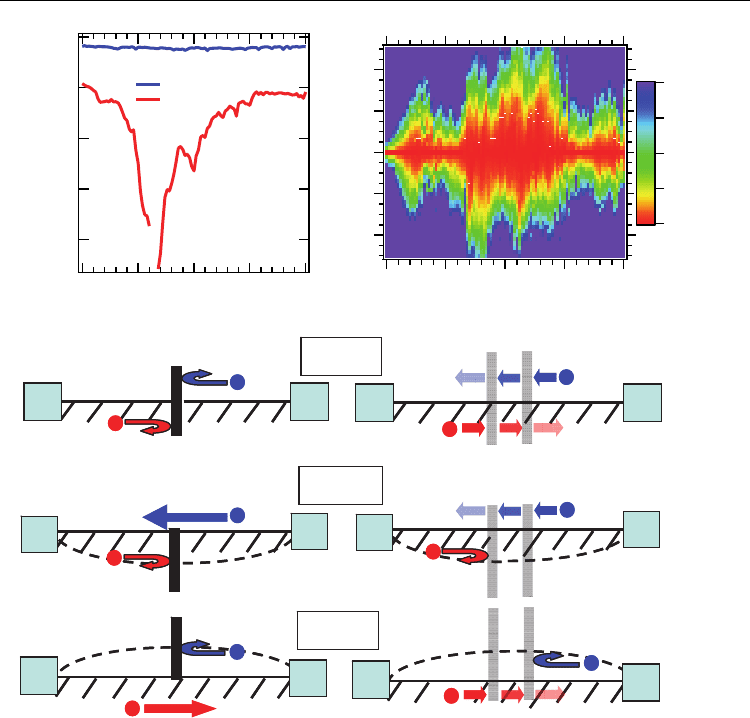
Electronic Properties of Carbon Nanotubes
344
Fig. 13. (a) Room-temperature gate voltage characteristics of a SWCNT device before and
after electron irardiation. The SWCNT was once scanned by an electron beam of 100 pA. The
electron energy and scan speed were 20 keV and 400 nm/s, respectively. (b) Room-
temperature Coulomb diamond characteristics of a SWCNT device before and after electron
irradiation. The SWCNT was once scanned by an electron beam of 500 pA. The electron
energy and scan speed were 20 keV and 400 nm/s, respectively. (c) Schematic explanations
of the defect-induced semiconductng properites. (d) Schematic explanations of the defect-
induced Coulomb oscillation properites.
5. Metal-semiconductor transition of a SWCNT-FET induced by defects
As mentioned in sec. 3.3, intensive irradiation finally makes a SWCNT almost insulating.
However, when the damage is moderate, a metal-semiconductor transition of the electric
properties is often observed. In our early study, we irradiated the whole device in a SEM and
10
-12
10
-11
10
-10
10
-9
10
-8
Drain current (A)
-10 -5 0 5 10
Gate voltage (V)
prisitne
irradiated
V
D
=0.1 V
(a)
-10 -5 0 5 10
Gate voltage (V)
-0.4
-0.2
0.0
0.2
0.4
Drain voltage (V)
4
3
2
1
0
x10
-9
(b)
V
G
=0
V
G
> 0
e
D
S
h
e
D
S
h
D S
E
F
e
h
D S
E
F
e
h
h
D S
E
F
e
h
D S
E
F
e
e
D
S
h
e
D
S
h
V
G
< 0
D
S
h
e
D
S
h
e
D
S
h
e
D
S
h
e
(c)
(d)
